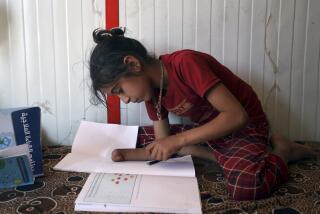15 Years After the Last Sortie, U.S. Cluster Bombs Still Killing, Maiming in Laos
- Share via
VIENTIANE, Laos — Fifteen years after the last sorties were flown, people still are being killed and maimed by the cluster bombs that U.S. warplanes dropped on rural Laos, U.S. relief workers say.
The fruit-shaped bombs, each about the size of a tennis ball, were dropped in a dispenser that split open before hitting the ground, scattering the bomblets.
Nicknamed “pineapples,” “guavas” and “oranges,” the anti-personnel cluster bombs are called “bombies” by Laotians. The U.S. military dropped them during the 1964-73 air war over Laos.
The recent dead include a mother of 10 hoeing her garden, two men digging a canal and children picking up and playing with the bombs, according to U.S. relief groups.
Hundreds of Victims
Although total casualty figures have not been compiled, the American Friends Service Committee and the Mennonite Central Committee say that hundreds have lost their lives or limbs to the bombies.
“There has been little systematic bombie-clearing by anyone,” said Roger Rumpf of the American Friends Servic Committee.
The once-strategic plateau of central Laos known as the Plain of Jars remains perhaps the most dangerous zone, and Rumpf said that large tracts of land can be farmed only at great risk. The area was turned into a veritable moonscape during the war, when Laotians say that 2 tons of bombs fell for every human being on the plain.
The area was a key communications and transport route between Vietnam, Laos and Thailand.
Eager for Help
The American Friends Service Committee and the Mennonite Central Committee--the only American aid organizations allowed into Communist Laos to date--have operated on a small scale.
Local officials reportedly are eager for outside help, even if it means U.S. military experts coming in to clear the unexploded ordnance. But the central Laotian government has rejected tentative offers for official American assistance, and proposals for such aid have been given the cold shoulder in the U.S. Congress.
“This is not our priority. Our priority is to promote agriculture,” said Vice Foreign Minister Soubanh Srithirath when asked about possible U.S. aid.
Rumpf has spent five years in Laos since the 1975 Communist victory over the U.S.-backed Vientiane government. His group has provided farmers with 20,000 shovels, said to be far safer than hoes, which tend to set off the bombs on impact.
Special Tractor
The Mennonites have tried driving a custom-built tractor with a special detonator through bomb-littered fields. Despite a protective shield, volunteers to drive the machine were reportedly few.
Now the Mennonites are awaiting word from Vientiane authorities on a program to set up bomb-clearing teams in each district of Xiengkhouang Province, where the Plain of Jars is located. The proposal was submitted a year ago.
Rumpf said the small bombs have become especially dangerous with the passing of time. Monsoon rains and erosion have driven some beneath the surface of fields, while others stay mixed in the topsoil.
Villagers often find the weapons a good source of income. The innards of the bombs are sold to the Vietnamese as ball bearings for bicycles, and casings are turned into wick lamps. The metal from larger bombs is fashioned into household utensils.
Historic Bomb Tonnage
The U.S. aid workers say that 10 people died and 12 were injured on the Plain of Jars since January this year. In May, five of the small bombs were found by a joint U.S.-Laotian team searching for the remains of Americans missing in action at a crash site in Savannakhet province.
Statistics vary, but standard histories say more bomb tonnage was dropped on Laos than on any country in history. Sometimes cited is the figure 2 million tons--more than the U.S. unleashed in all of World War II.
More to Read
Sign up for Essential California
The most important California stories and recommendations in your inbox every morning.
You may occasionally receive promotional content from the Los Angeles Times.










